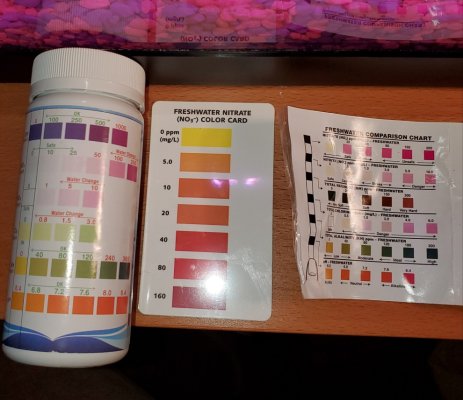I have a 20 gallon with ten fish and a handful of fry. In my attempts to efficiently feed the fry, I may overdo it to the point where the nitrates rise.
Ammonia, however, stays at zero. What I did is use the following strips: API, Tetra, and this one S & J I bought from Amazon. Daily tests with the strips give me a nitrite reading of zero, whereas the nitrate hovers between 25 - 40 according to the colors below.
As I'm really invested in this hobby, I thought to spend and buy the drop tests of Nitrate and PH, as well as Ammonia. The Ammonia is yellow, the ph reads a blue - not light blue - but blue, indicating a 7.6 - 7.8 reading. And the nitrate drops showed a reading of 15 - 20 indicated in the card below. So the strips and the drops matched.
I did a water change. Then, 48 hours later, as in today, I did the strips again and the drops, and the strips were reading identical as before, where as the drops for the nitrates were yellow - meaning zero.
So, could someone explain why the water change brought down the nitrates to zero according to the drops, but not the strips? Which is more accurate? As one who has a family business in pool construction, I am a bit familiar with water tests, and always advised customers the strips were never as accurate as the drops we use at the office to test water. Logic tells me the same is applied here. Am I wrong?
Ammonia, however, stays at zero. What I did is use the following strips: API, Tetra, and this one S & J I bought from Amazon. Daily tests with the strips give me a nitrite reading of zero, whereas the nitrate hovers between 25 - 40 according to the colors below.
As I'm really invested in this hobby, I thought to spend and buy the drop tests of Nitrate and PH, as well as Ammonia. The Ammonia is yellow, the ph reads a blue - not light blue - but blue, indicating a 7.6 - 7.8 reading. And the nitrate drops showed a reading of 15 - 20 indicated in the card below. So the strips and the drops matched.
I did a water change. Then, 48 hours later, as in today, I did the strips again and the drops, and the strips were reading identical as before, where as the drops for the nitrates were yellow - meaning zero.
So, could someone explain why the water change brought down the nitrates to zero according to the drops, but not the strips? Which is more accurate? As one who has a family business in pool construction, I am a bit familiar with water tests, and always advised customers the strips were never as accurate as the drops we use at the office to test water. Logic tells me the same is applied here. Am I wrong?

